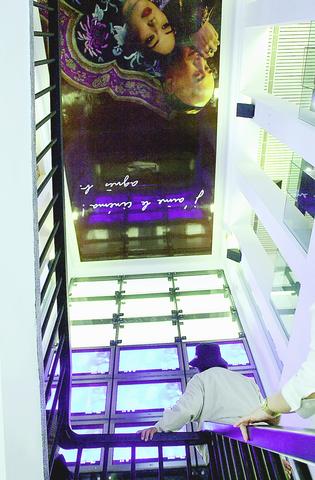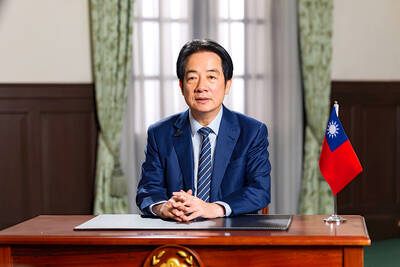It may be just another 100-year-old building, but after an extensive facelift, the former residence of US ambassador on Chungshan North Road is sporting a new look and a new purpose in life. The building, re-christened SPOT -- Taipei Film House, will officially open on Nov. 10 as an art house cinema and cultural venue.
The building, completed in 1901, when Taiwan was ruled by the Japanese, was long a focus of important diplomatic events. Between 1950 to 1979 it was home to six US ambassadors, and therefore the venue for many gatherings of Taiwan's cultural elite at a time when Taiwan was strongly influenced by the US, both politically and culturally.
"In the past, we were at a disadvantage, receiving culture and avant-garde arts from an outside culture. Now, our own artists can create avant-garde culture in this place," said Lung Ying-tai (龍應台), director of Taipei City's Bureau of Cultural Affairs, at a press conference yesterday announcing the venue's Nov. 10 opening.

PHOTO: CHEN CHEN-CHANG, TAIPEI TIMES
The renovation of the house began two years ago under the auspices of the cultural bureau and with NT$60 million in sponsorship from Taiwan Semiconductor Manufacturing Company (TSMC). Bidding for the management of the renovated building was won by acclaimed filmmaker Hou Hsiao-hsien's (侯孝賢) Association of Taiwan Film Culture (台灣電影文化協會), which planned to turn it into Taipei's first art house cinema screening non-Hollywood, independent and award winning films on a regular basis.
"In the past, as a filmmaker I used to complain to government officials about our poor cultural and film environment. Now maybe it's time to take some social responsibility and actually do something about it," Hou said.
From the outside, SPOT looks like a manor house from the American south. Inside, the building has been decorated in modern chic. The living room, where champagne parties used to be held, is now a cafe with French windows and a small terrace. And the long dining room has now become a mini branch of the Eslite Bookstore specializing in film-related books.
The master bedrooms and the guestroom on the second floor are now a bar and a VIP lounge. The ceiling of the second floor is decorated with a giant poster of Hou Hsiao-hsien's costume drama Flower of Shanghai, providing a Chinese touch.
As for the 88 seated cinema, this was originally the garage.
As Taipei's first art house cinema, SPOT will screen six films each day between 11am and 2am, selected by the Association of Taiwan Film Culture. This will be a great help to local filmmakers who always find it hard to screen their films in Taiwan, even when they have won awards in international film festivals.
Screenings were originally scheduled to begin on Nov. 10, but construction delays have put the opening of the cinema back to Nov. 15.
The opening film will be Mirror Image (命帶追逐2000), a film by Hou's pupil Hsiao Ya-chuan (蕭雅全). An urban rhapsody about destiny and coincidence, it was one of the entries at the Cannes Film Festival in 2001. Also selected as an opening feature is Fast Runner (2001) from Canada, a film about an Inuit hero leading his community in a fight against evil spirits.
A program of warmup screenings will take place between Nov. 11 to Nov. 14. (These where originally scheduled to commence last Saturday.) These films were selected by asking 10 top film professionals (writers and directors) to choose their personal favorite movies from the past five years. And, surprisingly, Hou's favorite was Hollywood sci-fi thriller, The Matrix.
SPOT -- Taipei Film House is located at 18 Chungshan N. Rd., Sec. 2, Taipei (台北市中山北路二段18號).

This month the government ordered a one-year block of Xiaohongshu (小紅書) or Rednote, a Chinese social media platform with more than 3 million users in Taiwan. The government pointed to widespread fraud activity on the platform, along with cybersecurity failures. Officials said that they had reached out to the company and asked it to change. However, they received no response. The pro-China parties, the Chinese Nationalist Party (KMT) and Taiwan People’s Party (TPP), immediately swung into action, denouncing the ban as an attack on free speech. This “free speech” claim was then echoed by the People’s Republic of China (PRC),

Exceptions to the rule are sometimes revealing. For a brief few years, there was an emerging ideological split between the Democratic Progressive Party (DPP) and Chinese Nationalist Party (KMT) that appeared to be pushing the DPP in a direction that would be considered more liberal, and the KMT more conservative. In the previous column, “The KMT-DPP’s bureaucrat-led developmental state” (Dec. 11, page 12), we examined how Taiwan’s democratic system developed, and how both the two main parties largely accepted a similar consensus on how Taiwan should be run domestically and did not split along the left-right lines more familiar in

Many people in Taiwan first learned about universal basic income (UBI) — the idea that the government should provide regular, no-strings-attached payments to each citizen — in 2019. While seeking the Democratic nomination for the 2020 US presidential election, Andrew Yang, a politician of Taiwanese descent, said that, if elected, he’d institute a UBI of US$1,000 per month to “get the economic boot off of people’s throats, allowing them to lift their heads up, breathe, and get excited for the future.” His campaign petered out, but the concept of UBI hasn’t gone away. Throughout the industrialized world, there are fears that

The Democratic Progressive Party (DPP) controlled Executive Yuan (often called the Cabinet) finally fired back at the opposition-controlled Legislative Yuan in their ongoing struggle for control. The opposition Chinese Nationalist Party (KMT) and Taiwan People’s Party (TPP) acted surprised and outraged, but they should have seen it coming. Taiwan is now in a full-blown constitutional crisis. There are still peaceful ways out of this conflict, but with the KMT and TPP leadership in the hands of hardliners and the DPP having lost all patience, there is an alarming chance things could spiral out of control, threatening Taiwan’s democracy. This is no